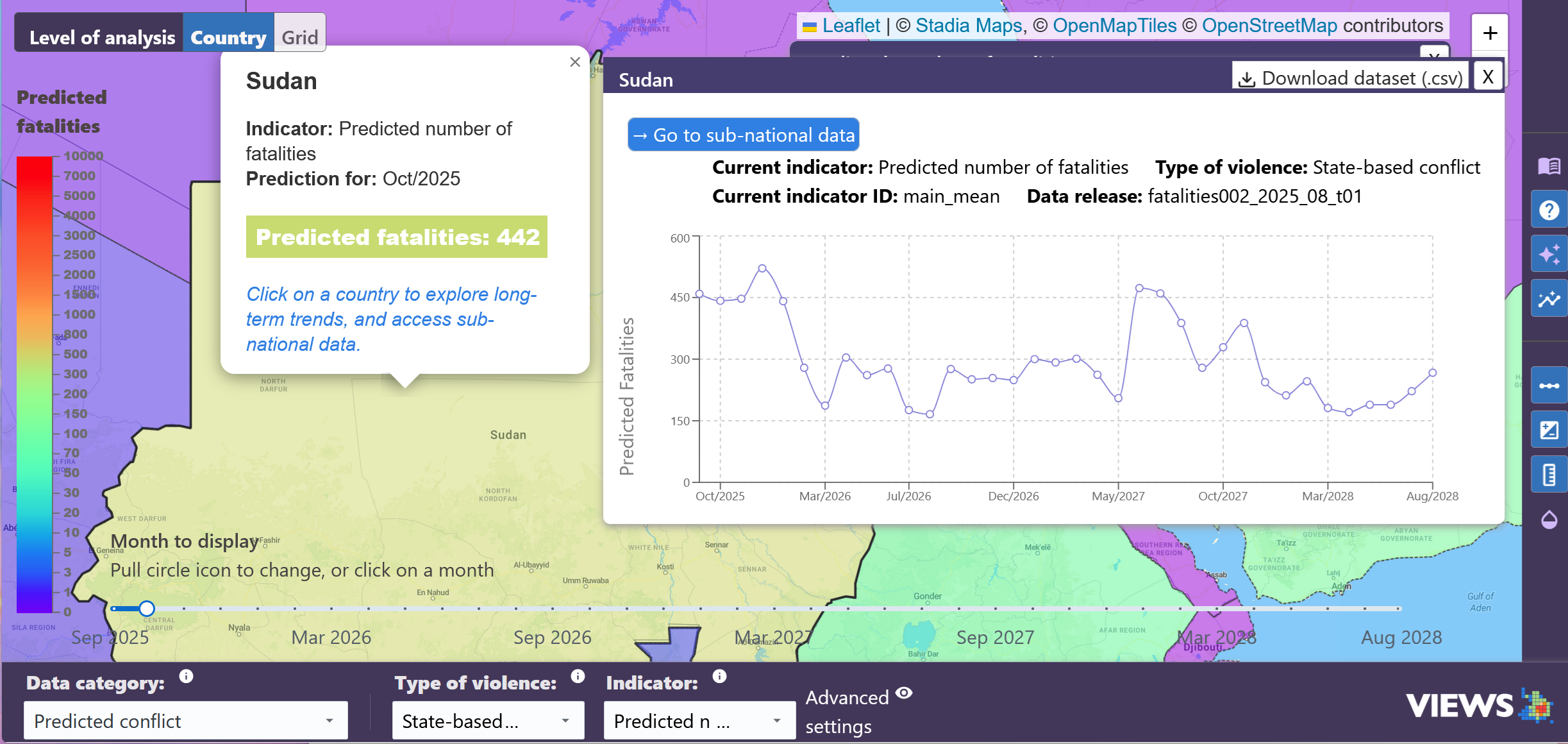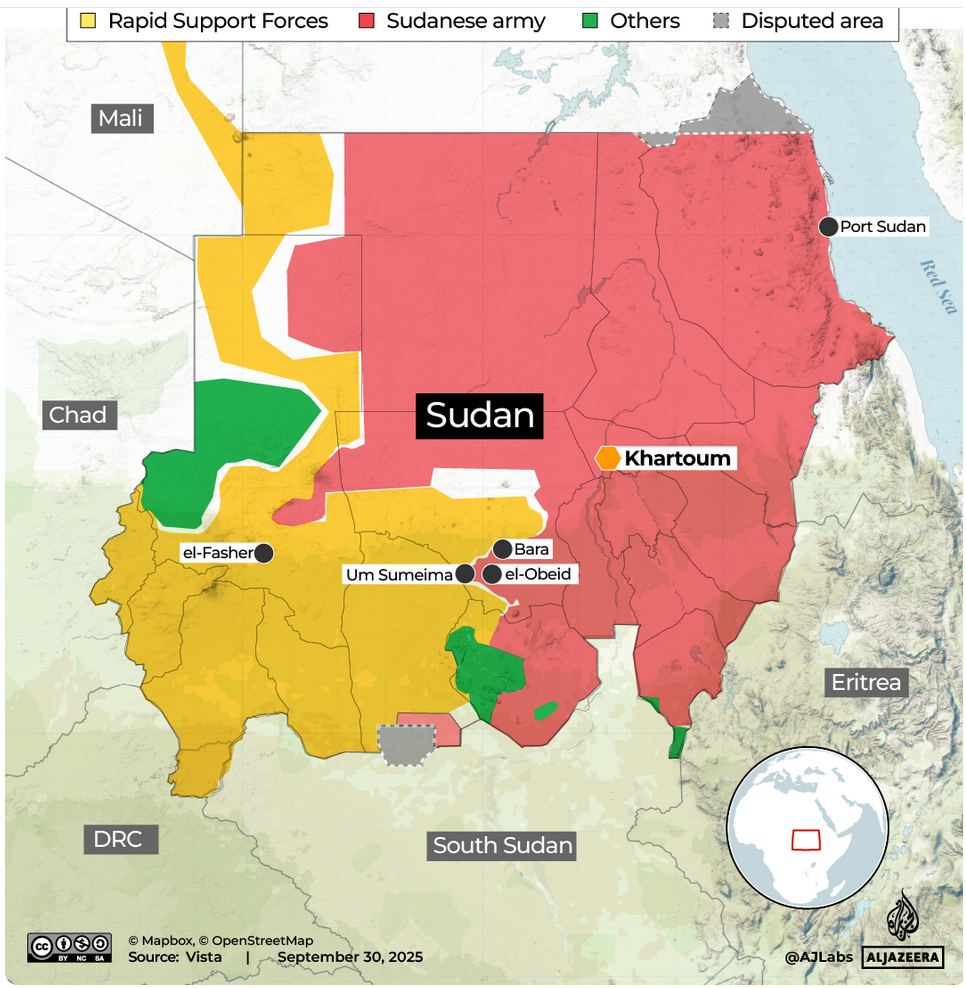How many state-based conflict deaths in Sudan will be reported by ACLED for 2025?
Jeremy Lichtman’s Multi-AI Oracle predicts today:
Less than 1,000: 1%
Between 1,000 and 3,000: 5%
Between 3,000 and 5,000: 12%
Between 5,000 and 8,000: 22%
Between 8,000 and 12,000: 35%
More than 12,000: 25%
12–15 minutes read
Obtaining outside data.
Checking internet sources, using keywords: Sudan 2025 deaths
News from various sources:
The situation in Sudan, particularly in El-Fasher, Darfur, remains critical in 2025 following a prolonged conflict between Sudan’s army and the paramilitary Rapid Support Forces (RSF). The RSF, a group descended from the Janjaweed militias, has been accused of committing widespread atrocities, including ethnic violence, executions of civilians, and assaults on hospitals in El-Fasher, which recently fell under their control.
The conflict, which began in April 2023, intensified with the RSF’s seizure of El-Fasher, the last stronghold of the Sudanese army in Western Sudan. This move has escalated fears of a resurgence of genocidal violence, similar to the events in Darfur two decades ago. Reports indicate that the RSF has been responsible for house-to-house killings, massacres in hospitals, and the establishment of barriers to prevent civilians from escaping.
The war has led to tens of thousands of deaths and has displaced more than 14 million people, creating a dire humanitarian crisis. United Nations estimates suggest around 200,000 civilians were trapped in El-Fasher at the time of its capture, with more than 26,000 fleeing to nearby regions since the fall.
International bodies, including the United Nations and advocacy groups, have called attention to the RSF’s actions, labeling them as war crimes and urging international intervention. Despite these calls, the conflict remains unresolved, with minimal prospects for peace as both sides accuse one another of severe human rights abuses. The RSF’s recent military gains have tightened their control over one-third of Sudan, complicating peace efforts and entrenching divisions across the nation.
Fact-checking news summary:
Based on the provided summary, here is a list of specific facts, including an analysis of their accuracy, importance to the question about ACLED’s report on state-based conflict deaths in Sudan in 2025, and relevance to the outcome:
1. **Fact:** The situation in Sudan, particularly in El-Fasher, Darfur, remains critical in 2025.
– **Correctness:** Internally consistent, but no external data to verify the situation in 2025 specifically. **True** in the context provided.
– **Importance to Question’s Resolution:** Important, as it provides context for conflict-related deaths.
– **Relevance to Outcome:** True. Understanding the intensity of the conflict is relevant to predicting casualty numbers.
2. **Fact:** The conflict is between Sudan’s army and the paramilitary Rapid Support Forces (RSF).
– **Correctness:** True. This is a well-documented conflict as of the latest updates in 2023.
– **Importance to Question’s Resolution:** Important, as identifying conflict parties helps estimate conflict dynamics.
– **Relevance to Outcome:** True. Knowing who is involved is essential to understanding the conflict scope.
3. **Fact:** The RSF descended from the Janjaweed militias and is accused of atrocities like ethnic violence and civilian executions.
– **Correctness:** True, as RSF’s origins from Janjaweed are documented, and accusations exist.
– **Importance to Question’s Resolution:** Important, as RSF’s behavior impacts conflict escalation.
– **Relevance to Outcome:** True, such activities could influence death tolls.
4. **Fact:** El-Fasher recently fell under the control of RSF.
– **Correctness:** Internally consistent, but “recently” is context-dependent. **True** if contextual to the narrative timeline.
– **Importance to Question’s Resolution:** Lesser, but offers important context about the conflict’s progression.
– **Relevance to Outcome:** True. Changes in territorial control can affect conflict dynamics and casualties.
5. **Fact:** The conflict began in April 2023.
– **Correctness:** True, according to available reports.
– **Importance to Question’s Resolution:** Important, as the conflict’s duration affects death toll projections.
– **Relevance to Outcome:** True, the start date informs trends in violence.
6. **Fact:** RSF’s seizure of El-Fasher was the last stronghold of the Sudanese army in Western Sudan.
– **Correctness:** Needs external confirmation, but internally consistent. **True** if within narrative context.
– **Importance to Question’s Resolution:** Lesser, but helps map conflict progression.
– **Relevance to Outcome:** True, informs on RSF’s military position and potential conflict scale.
7. **Fact:** The war has led to tens of thousands of deaths and displaced more than 14 million people.
– **Correctness:** The high displacement figure seems exaggerated compared to known data as of 2023. Likely **False** for displacement; deaths’ figure needs confirmation.
– **Importance to Question’s Resolution:** Critical, as it pertains directly to conflict impact.
– **Relevance to Outcome:** True for deaths, impacts the prediction of ongoing casualties.
8. **Fact:** United Nations estimates around 200,000 civilians were trapped in El-Fasher when captured.
– **Correctness:** No verification available for specific location or exact number. Needs confirmation, presumed **True** in context.
– **Importance to Question’s Resolution:** Important, situational specifics may affect casualty estimates.
– **Relevance to Outcome:** True, affects understanding of humanitarian and casualty context.
9. **Fact:** More than 26,000 fled El-Fasher since its fall.
– **Correctness:** Needs external verification, presumed **True** in narrative context.
– **Importance to Question’s Resolution:** Lesser, but offers insight on population movements.
– **Relevance to Outcome:** True, informs context of conflict’s humanitarian impact.
10. **Fact:** International bodies have called for intervention, labeling RSF’s actions as war crimes.
– **Correctness:** True, given documented international responses.
– **Importance to Question’s Resolution:** Lesser but contextual for understanding conflict responses.
– **Relevance to Outcome:** True, as international reactions can influence conflict resolution efforts.
11. **Fact:** The RSF controls one-third of Sudan.
– **Correctness:** Needs confirmation; control extent often fluctuates. Contextually **True** but needs external data.
– **Importance to Question’s Resolution:** Important for understanding conflict dynamics.
– **Relevance to Outcome:** True, as control affects conflict spread and casualties.
Overall, most facts provide a crucial context for understanding the situation in Sudan, influencing the estimations of conflict deaths ACLED might report in 2025.
Fact-checked summary:
The situation in Sudan in 2025 remains critical, particularly in El-Fasher, Darfur, with an ongoing conflict between Sudan’s army and the paramilitary Rapid Support Forces (RSF), originating from the Janjaweed militias. This conflict, which began in April 2023, is key to understanding the potential casualty numbers, as the parties involved and their actions, including documented atrocities by the RSF, significantly impact conflict dynamics and the death toll. El-Fasher recently fell under RSF control, highlighting the shifting territorial control that can influence conflict and casualty trends. An estimate by the United Nations suggested that 200,000 civilians were trapped in El-Fasher when it was captured, and since then, more than 26,000 people have reportedly fled the area, illustrating the conflict’s humanitarian impact. International bodies have labeled RSF’s actions as war crimes, which affects the international response and potential resolution efforts. Understanding these factors provides crucial context for estimating conflict deaths that organizations like ACLED might report for Sudan in 2025.
OpenAI gives a base rate of probability of more than 8,000 deaths
The question difficulty is rated 7 (0 to 10)
Historical weighted factors include:
Previous conflict deaths in Sudan (2024), 0.4
International intervention success rates in similar conflicts, 0.2
UN reports on trapped and fleeing civilians, 0.3
Historical patterns of civilian casualties in El-Fasher conflicts, 0.1
A Bayesian calculation could be performed as follows:
Using the historical factors, the calculation includes: prevalence of conflict deaths from 2024 (assuming a number of casualties in high thousands), low success rate of international interventions in similar contexts, and significant humanitarian crises reported by UN as strong indicators. Bayesian updating uses a prior of 0.6 (based on historical data and conflict intensity) adjusted upwards by the humanitarian impact and RSF’s violent actions.
Bayesian base rate: 0.73
Sufficient news to provide a good forecast? 1 (0 or 1)
News is relevant, topical and unbiased? 1 (0 or 1)
Question classification: scenario_based_forecast
Expected time (days) until question close: 60
The following were considered in order to produce this base rate:
Analyzing the base rate took into account the current intensity of the conflict between the army and RSF, historical casualty rates in Sudan, as well as control shifts and RSF’s control of territories, which have heightened the likelihood of increased fatalities.
Ideally, the news feed would contain the following sorts of information for a better forecast:
To improve forecast accuracy, detailed casualty reports from credible agencies, ongoing updates on the conflict dynamics, and insights into the capacity of international bodies to mediate effectively should be considered.
Some potential divergent considerations that might affect the base rate:
If there is an unexpected and effective international intervention, or if the conflict parties suddenly reach a ceasefire agreement, the actual death toll could significantly diverge from current expectations.
The following chain of events are necessary for the question to resolve positively:
– Continued violent clashes between Sudan’s army and RSF Almost certain
– Lack of successful peace negotiations or ceasefire arrangements Likely
– Persistent RSF control over territories and execution of documented atrocities Likely
– Potential increase in international intervention, despite ongoing atrocities Moderate
Querying Claude (AI predicts: [“Less than 1000”: 0.01, “Between 1000 and 3000”: 0.05, “Between 3000 and 5000”: 0.12,
“Between 5000 and 8000”: 0.22, “Between 8000 and 12000”: 0.35, “More than 12000”: 0.25] – confidence: 6)
Querying Mistral (AI predicts: [“Less than 1000”: 0.01, “Between 1000 and 3000”: 0.05, “Between 3000 and 5000”: 0.15,
“Between 5000 and 8000”: 0.29, “Between 8000 and 12000”: 0.35, “More than 12000”: 0.15] – confidence: 5)
Querying OpenAI (AI predicts: [“Less than 1000”: 0.01, “Between 1000 and 3000”: 0.05, “Between 3000 and 5000”: 0.1, “Between 5000 and 8000”: 0.19, “Between 8000 and 12000”: 0.25, “More than 12000”: 0.4] – confidence: 6)
Question Type: Multiple Choice
Confidence: 6
MAPD: Avg: 0.055555555555556, Max: 0.16666666666667
# LLM responses: 3
Explanations of the above statistical measures here —>
Model value:
Less than 1,000: 1%
Between 1,000 and 3,000: 5%
Between 3,000 and 5,000: 12%
Between 5,000 and 8,000: 22%
Between 8,000 and 12,000: 35%
More than 12,000: 25%
The reasoning across the AI predictions prominently highlights the prolonged and intense conflict between Sudan’s army and the RSF, emphasizing the RSF’s continued territorial advancements and documented atrocities, such as the recent capture of El-Fasher. These factors, coupled with the lack of successful peace negotiations and limited international intervention, suggest a high probability of significant casualties. Historical patterns of conflict in Sudan and the present intensity further support the expectation of a death toll potentially exceeding 8,000, with a considerable chance of surpassing 12,000. However, the predictions could be challenged by unforeseen breakthroughs in peace efforts, effective international intervention, or changes in conflict dynamics, such as a sudden ceasefire or altered territorial control that might reduce violence. Additionally, the accuracy of casualty data reporting and the methodology used to categorize deaths could influence the predictions.
Runtime: 150 seconds.
Past forecasts by Phil’s and Jeremy ’s bots —>
Below, a forecast of state-based conflict fatalities for Sudan in the VIEWS machine forecasting competition, which is an aggregate of the forecasts of twenty machine learning competitors. Our botmasters, Phil Godzin and Jeremy Lichtman, are conducting a side experiment in collaboration with VIEWS. The VIEWS aggregate forecast is much lower than ours.

Source: VIEWS machine forecasting competition

Control of territory, Sept. 2025. Source: https://www.aljazeera.com/features/2025/9/30/war-in-sudan-humanitarian-fighting-control-developments-september-2025

